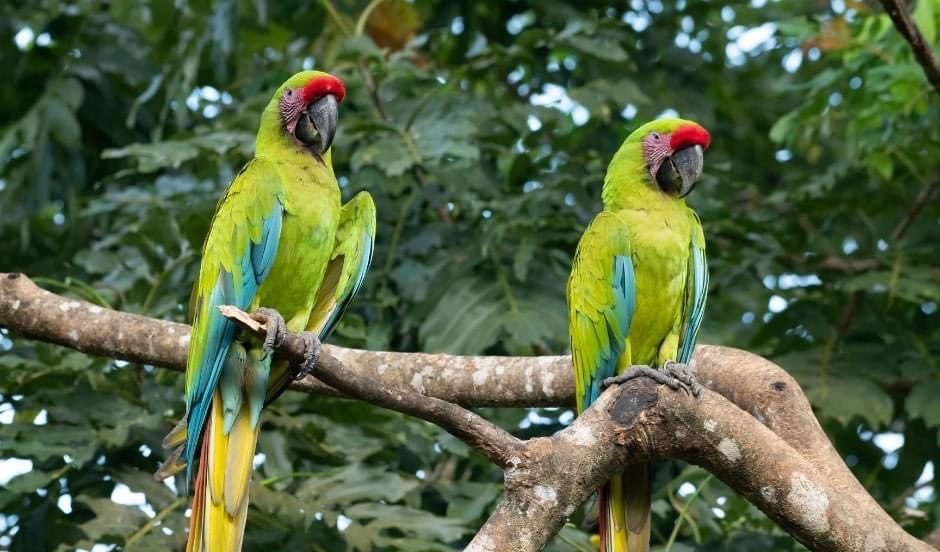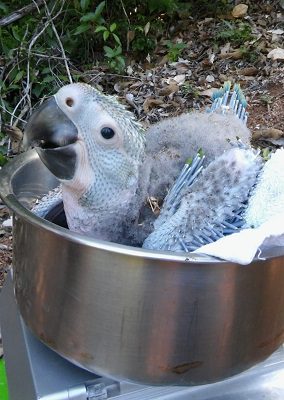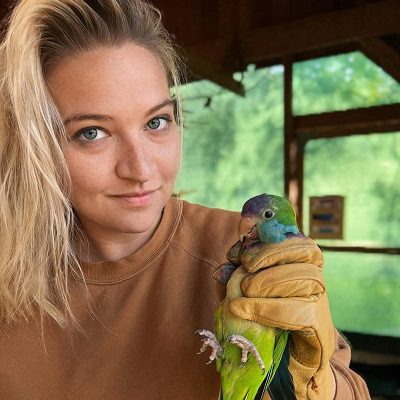Darby Moore ’17 on a mission to protect endangered species

There are only 500 great green macaws living in the wild and about the same number currently living in captivity. Prized for their vibrant plumage and known for their size of nearly a meter long, the majestic parrots are highly endangered, having fallen victim to poachers, animal trafficking and habitat destruction.
But Furman University alumna V. Darby Moore ’17 aims to help restore populations of the great green macaw and other threatened species. She was featured in a National Geographic docuseries, Costa Rica: Animals Return, where she appears in the film around the 23-minute mark. The biology and art graduate is shown taking care of the flamboyant creatures as part of the Macaw Recovery Network in the Guanacaste Province of Costa Rica where she worked after graduating Furman.

Great green macaws produce a single chick each year. Photo: Macaw Recovery Network.
In the documentary, Moore gingerly places a 22-day-old chick in a terry-lined nest. Without complaint, the chick allows Moore to reveal the beginnings of pinfeathers on its wings. The singular chick, Almendro, is the only offspring its parents would produce that year. At most, the great birds raise up to three a year.
“We think it’s important to breed them in captivity so we can have the best chick survivability possible,” Moore said. “And then we release them so that they can reproduce in the wild better.”
Thanks in part to an NSF GRFP grant awarded to Moore this year, she is now furthering her studies of animal behavior and reintroduction science at the University of Cincinnati’s Hobson Lab. During a springtime call, her voice mingled with the chatter of 30 monk parakeets, residents at the lab’s field office hosted by the USDA in Gainesville, Florida.
“My aim is to quantify differences in behavior between young monk parakeets raised by their parents and those raised with minimal contact by human researchers,” explained Moore who uses a monk parakeet model to explore how early life experiences impact their social behavior as adults.
She said the differences may shed light on what social information juvenile parakeets learn from their parents. She also plans to conduct a long-term study to determine if monk parakeets can change their interactions as adults when presented with new social information after introduction to a larger group.

Darby Moore holds monk parakeet. Photo: University of Cincinnati, Hobson Lab.
“This research is interesting from the perspective of animal behavior, but it also has important implications for the field of reintroduction science,” Moore said, citing threatened species in Central and South America. “Unlike other tropical species, some parrot species are common in the pet trade despite being endangered. Breeding ex-pet parrots in captivity and releasing their young into the wild is becoming more popular as a conservation tool.
“We used this exact strategy at the Macaw Recovery Network to release scarlet and great green macaws into the wild, but many captive breeding and reintroduction practices are understudied from a scientific perspective. My proposed research has the potential to inform management strategies for parrot reintroduction programs.”
Meantime, Moore will travel to the 2nd Ornithological Congress of the Americas in Gramado, Brazil. She’ll give a presentation about how technology helps scientists understand animal behavior and aid conservation projects, especially those focused on returning captive animals to their natural habitats.